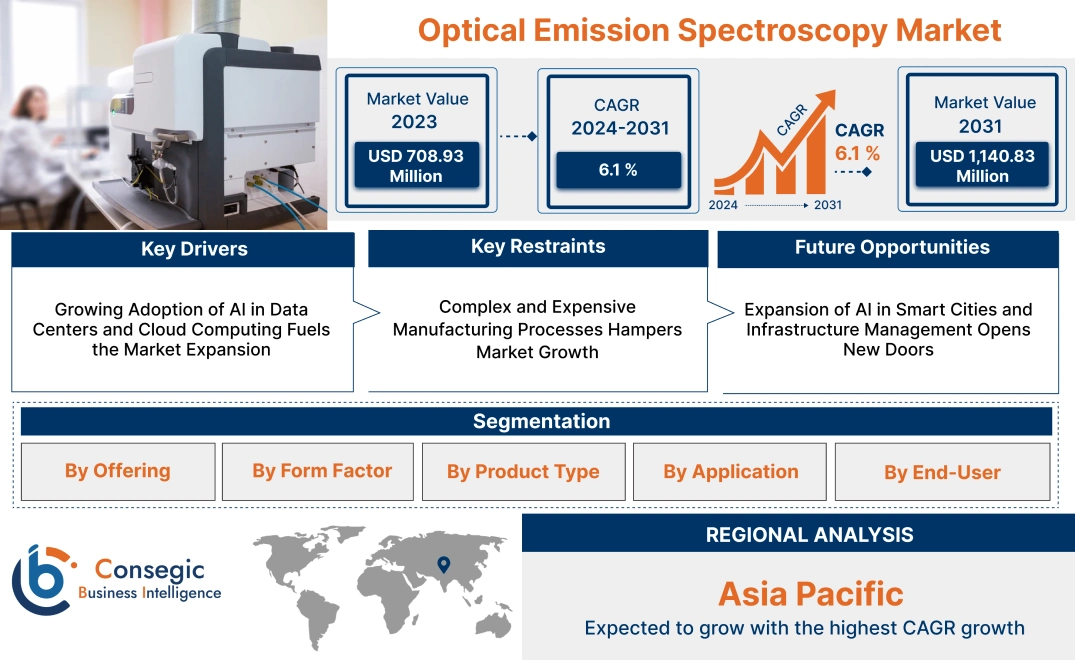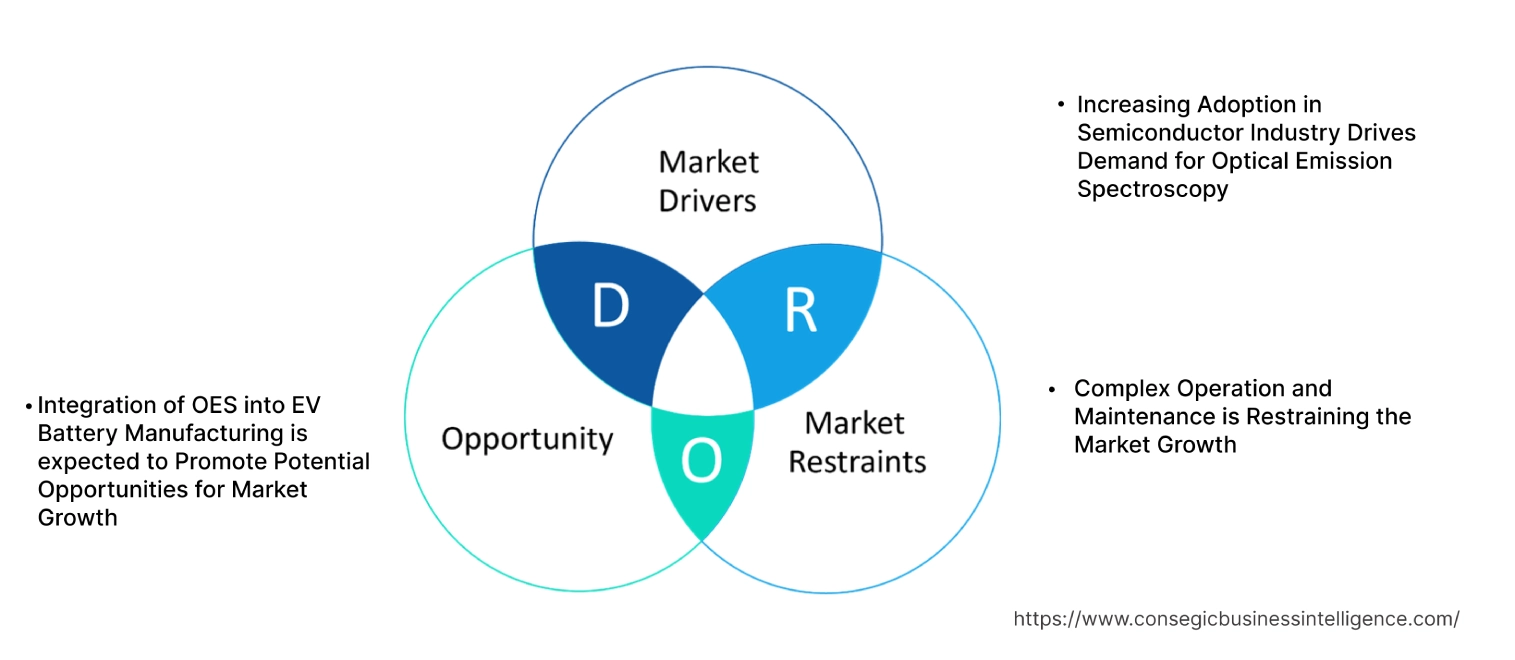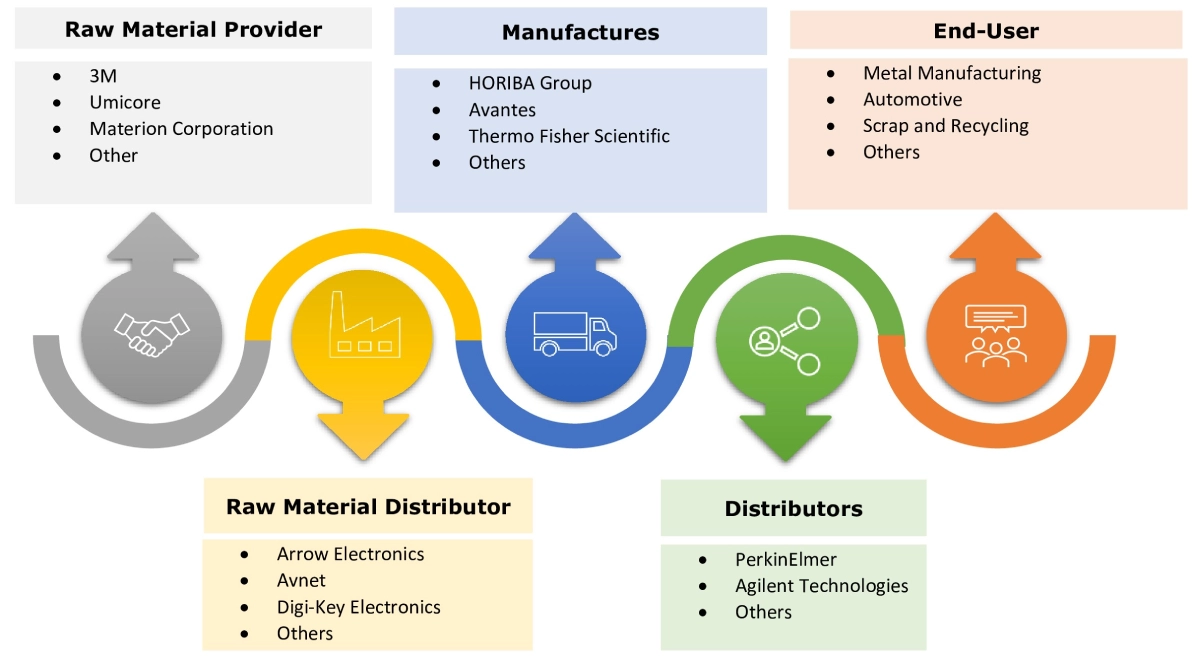Optical Emission Spectroscopy Market Size:
Optical Emission Spectroscopy Market Size is estimated to reach over USD 1,222.70 Million by 2032 from a value of USD 739.74 Million in 2024 and is projected to grow by USD 774.55 Million in 2025, growing at a CAGR of 5.9% from 2025 to 2032.
Optical Emission Spectroscopy Market Scope & Overview:
Optical emission spectroscopy (OES) is a widely used technique in various devices to identify the elemental composition of metals. It employs arc and spark excitation methods to analyze trace metals, revealing the chemical composition of metallic samples. This method is particularly valuable across industries such as oil and gas, metals and heavy machinery, automotive, and scrap and recycling. Its widespread adoption is primarily driven by its rapid assessment time and inherent accuracy, making it an efficient and reliable tool for determining metal composition.
Optical Emission Spectroscopy Market Dynamics - (DRO) :
Key Drivers:
Growing adoption of OES techniques in the semiconductor sector is driving the optical emission spectroscopy market expansion
Spectroscopy is an essential technique for ensuring quality control and conducting wafer probing testing in the manufacturing of finished semiconductor wafers. It offers specific advantages for semiconductor applications, including high resolution, high-speed measurement capability, and thin film measurement applications. Furthermore, the ongoing inclination of miniaturization in semiconductor devices is a significant driver for the optical emission spectroscopy (OES) market, due to the capability to precisely control and monitor the very small dimensions involved during the critical etching process.
- For instance, in August 2021, HORIBA Scientific announced the collaboration with Covalent Metrology, to establish the first demonstration laboratory in North America. This lab aims to expedite research and development efforts across the semiconductor, electronics, and advanced materials industries.
Thus, according to the optical emission spectroscopy market analysis, the growing adoption of OES techniques in the semiconductor sector is driving the optical emission spectroscopy market size.
Key Restraints :
The high maintenance cost of OES systems is affecting the optical emission spectroscopy market demand
The initial investment required for purchasing and installing ICP (Inductively Coupled Plasma)-OES instruments can be substantial, which may be a barrier for small and medium-sized enterprises (SMEs) and research institutions with limited budgets. Additionally, the cost of maintenance, calibration, and training can add to the overall expenses, making it a significant consideration for potential buyers.
Further, in the rapidly evolving metal production sector, spectroscopy is crucial for product quality control. However, effectively utilizing this technique demands skilled operators who can optimize complex processes to ensure consistent product quality and adherence to regulatory standards. Thus, the aforementioned factors would further impact the optical emission spectroscopy market size.
Future Opportunities :
Growing incorporation of OES into electric vehicles (EVs) manufacturing is expected to create potential growth for optical emission spectroscopy market opportunities
The growing adoption of electric vehicles is driving the increased demand for EV batteries. This is further boosting the need for optical emission spectroscopy (OES) in the recycling of battery metals. This application of OES is crucial for achieving sustainability goals and complying with stringent government regulations aimed at combating climate change. Additionally, the integration of advanced spectroscopy techniques into the battery production process plays a vital role in significantly reducing impurities in battery metals. This not only enhances the quality of the batteries but also reduces the overall analysis time.
- For instance, in January 2023, Sensmet introduced an innovative online monitoring system designed to enhance the manufacturing and recycling of battery metals. This technology integrates ICP-OES directly into the production process. This integration allows fully automated, real-time measurement of metal concentrations, providing immediate data for critical quality control.
Thus, based on the above optical emission spectroscopy market analysis, the growing incorporation of OES into electric vehicles (EVs) manufacturing is expected to drive the optical emission spectroscopy market opportunities.
Optical Emission Spectroscopy Market Segmental Analysis :
By Offering:
Based on offering, the optical emission spectroscopy market is segmented into equipment and service.
Trends in the offering:
- The market for high-quality spectroscopy equipment is expanding due to its increasing demand within the pharmaceutical and medical sectors.
- The continuous technological advancements in spectroscopy instruments are driving the need for specialized services. These services are crucial for upgrading existing spectroscopy equipment to the latest versions, ensuring they remain relevant and perform optimally.
- Thus, based on the above analysis, these factors are driving the optical emission spectroscopy market demand.
The equipment segment accounted for the largest revenue in the year 2024.
- The equipment segment dominates the market, holding the largest share due to the high cost and technological complexity of ICP-OES instruments.
- These instruments are integral to the spectroscopy process and are in high need across multiple industries such as environmental testing, pharmaceuticals, and food and beverage testing.
- The continuous advancements in equipment technology, including enhanced sensitivity and accuracy, are further driving the segment development.
- For instance, in November 2023, SPECTRO Analytical Instruments launched an enhanced version of its SPECTRO GENESIS ICP-OES (Inductively Coupled Plasma - Optical Emission Spectrometry) system. This upgraded instrument offers a blend of high performance and value, incorporating significant advancements such as increased sensitivity, compact design, and improved ergonomics.
- Thus, based on the above analysis, these factors are further creating opportunities in the global market.
The service segment is anticipated to register the fastest CAGR during the forecast period.
- Services include maintenance, calibration, training, and consultancy, which are essential for the optimal functioning of ICP-OES systems.
- The increasing focus on preventive maintenance and the need for skilled personnel to operate sophisticated instruments are propelling the need for services.
- Additionally, laboratories are increasingly outsourcing these services to specialized providers to reduce operational costs and ensure compliance with regulatory standards.
- For instance, in September 2023, SGS Société Générale de Surveillance SA expanded its service offerings by opening a new lithium examination hub in Kalgoorlie, Australia. This facility is equipped with both plasma mass spectrometry and inductively coupled plasma optical emission spectroscopy to enhance its analytical capabilities.
- Thus, based on the above analysis, these factors are expected to drive the optical emission spectroscopy market share during the forecast period.
By Form Factor:
Based on the form factor, the market is segmented into stationary OES and mobile OES.
Trends in the form factor:
- The growing need for real-time monitoring and controlled analysis is driving the segment development.
- The growing practice of incorporating stationary OES instruments directly into production lines for quality control is driving the need for stationary OES systems.
The stationery OES segment accounted for the largest revenue share in the year 2024.
- Stationary OES is crucial for high-performance, precise investigations, making it ideal for complex and detailed consideration.
- Industries like metals, mining, and materials science rely on it for accurate and dependable results, particularly for rigorous testing and quality control.
- The advanced features of stationary OES boost its analytical power, making it a preferred choice for both laboratory and industrial applications, thereby driving growth of the stationary OES segment.
- Thus, based on the above analysis, these factors would further supplement the optical emission spectroscopy market share.
The mobile OES segment is anticipated to register the fastest CAGR during the forecast period.
- The need for mobile OES instruments is increasing across various industries, largely due to their compactness and portability.
- The key benefits of using mobile OES include their ease of use, capacity for on-site assessment, and minimal sample preparation, which makes them ideal for remote and field applications.
- For instance, Hitachi High-Tech offers two distinct mobile OES instruments, the PMI-MASTER Smart and the PMI-MASTER Pro2. These instruments are highly suitable for analyzing various metals and alloys, including steel, aluminum, and nickel. They are also ideal for tasks such as material verification and quality control.
- These factors are anticipated to further drive the optical emission spectroscopy market trends during the forecast period.
By Product Type:
Based on product type, the market is segmented into arc/spark and inductively coupled plasma (ICP).
Trends in the product type:
- The need for high resolution, high-speed measurement, and thin film measurement capabilities in OES instruments is driven by the miniaturization of semiconductor devices and the need to control very small dimensions during processes like etching.
- There is a rising need for high-quality spectroscopy equipment for elemental impurity analysis in drug formulations and raw materials, ensuring product safety and regulatory compliance.
The arc/spark segment accounted for the largest revenue share in the year 2024.
- Arc/Spark excitation is a critical component in the optical emission spectroscopy market due to its high accuracy, sensitivity, and reliability in analyzing metallic samples.
- This method is essential for the precise elemental investigation of various materials, including metals and alloys, across diverse industries such as manufacturing, automotive, aerospace, and research laboratories.
- Furthermore, the technological advancements in Arc/Spark OES, offering improved detection limits and faster testing times for quality control and material verification, are significantly fueling the growth of this segment.
- Thus, the above factors are driving the optical emission spectroscopy market growth and trends.
The inductively coupled plasma (ICP) segment is anticipated to register the fastest CAGR during the forecast period.
- The inductively coupled plasma (ICP) is a key technology in analytical chemistry due to its high sensitivity, multi-element assessment capabilities, and low detection limits.
- These features are vital for accurately identifying trace elements in environmental samples like soil and water, thereby ensuring compliance with stringent regulatory standards and driving the need for ICP applications.
- Furthermore, ICP offers several significant advantages, including the ability to perform simultaneous detection of multiple elements, easy identification of both the types and ratios of elements, superior sensitivity, and broader elemental coverage as compared to other techniques.
- For instance, Thermo Fisher Scientific Inc. offers iCAP PRO Series ICP-OES systems, which are suited for laboratories with lower sample processing needs. These systems are available with advanced features, including both iFR and eUV analysis modes.
- These factors are anticipated to further drive the optical emission spectroscopy market trends during the forecast period.
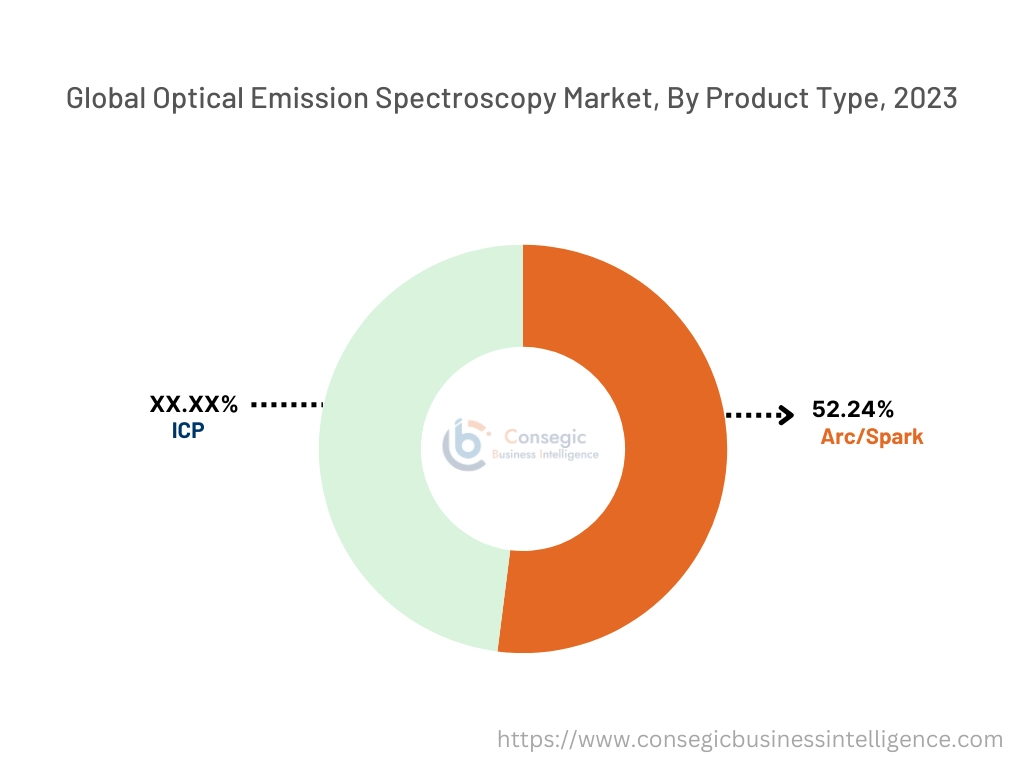
By Application:
Based on application, the market is segmented into environmental analysis, chemical analysis, pharmaceutical & cosmetic analysis, mining element analysis, material analysis, nuclear energy analysis, and others.
Trends in the application:
- The growing investment in scientific research and the increasing number of research projects that require advanced analytical techniques are driving the adoption of OES in academic and research institutions.
- As the need for advanced electronic devices continues to grow, the sales of ICP etching systems are expected to rise, further bolstering the market expansion.
The chemical analysis segment accounted for the largest revenue share of 23.45% in the year 2024.
- OES is primarily employed for chemical analysis due to its capacity for rapid elemental analysis in materials testing and quality control.
- Furthermore, the spectroscopy technique's ability to deliver precise quantitative analysis makes it a preferred method within the chemical analysis segment.
- Thus, the aforementioned factors are driving the optical emission spectroscopy market growth and trends.
The material analysis segment is anticipated to register the fastest CAGR during the forecast period.
- The spectroscopy technique is a valuable tool for material analysis due to its ability to provide rapid and accurate elemental analysis of diverse materials. This capability is crucial for ensuring product quality and adherence to manufacturing standards.
- Furthermore, manufacturers in the automotive and aerospace sectors rely on these instruments to verify material integrity and comply with stringent industry rules and regulations, thereby driving the advancement of the segment.
- These developments are anticipated to further drive the global market during the forecast period.
By End-Use:
Based on end user, the market is segmented into oil and gas, metal manufacturing, automotive, scrap and recycling, aerospace and defense, chemicals, infrastructure, pharmaceuticals and life sciences, power generation, food and beverages, environmental, and others.
Trends in the end user:
- The growing emphasis on environmental protection and public health and the need for quality control and process optimization in various industries is expected to drive the need for OES systems across different end-user segments.
- The increasing incidences of food fraud and contamination scandals have heightened the need for robust testing methods. As a result, food testing laboratories are increasingly adopting OES technology to provide precise and quick assessments.
The metal manufacturing segment accounted for the largest revenue in the year 2024.
- Metal manufacturers extensively use spectroscopy techniques to analyze the composition of metals and alloys, ensuring the accurate determination of their fundamental elemental composition.
- The primary function of spectroscopy in metal manufacturing is to verify the chemical composition of various metals, steels, and alloys. This crucial step enables businesses to consistently maintain desired material properties and performance characteristics in their products.
- For instance, in September 2021, Bruker introduced the Q4 POLO, a compact OES system. This new instrument offers enhanced analytical performance for a variety of applications within metal manufacturing.
- Thus, the above developments are driving the global market.
The automotive segment is anticipated to register the fastest CAGR during the forecast period.
- OES is increasingly used in the automotive sector as an ideal solution for inspecting metal parts, thereby boosting the need for these analytical techniques.
- Within the automotive sector, OES instruments play a crucial role in the production of EV batteries by offering ultra-fast elemental depth profiling of both thin and thick films, which is significantly spurring market development.
- Furthermore, spectroscopy contributes to the automotive industry by ensuring quality control, optimizing operational efficiency, and addressing environmental concerns.
- These factors are anticipated to further drive the global market during the forecast period.
Regional Analysis:
The global market has been classified by region into North America, Europe, Asia-Pacific, Middle East & Africa, and Latin America.

Asia Pacific optical emission spectroscopy market expansion is estimated to reach over USD 268.99 million by 2032 from a value of USD 152.42 million in 2024 and is projected to grow by USD 160.50 million in 2025. Out of this, the China market accounted for the maximum revenue split of 32.23%. The region is expected to witness substantial growth in the global market, driven by the growing industrial sector. Further, rapid industrialization and urbanization in countries like China and India are fueling a surge in the need for advanced analytical technologies such as OES. This demand spans diverse applications, including metallurgy and food safety. Furthermore, the region's increasing focus on environmental protection has created new prospects for OES in monitoring water and air quality. These trends would further drive the regional optical emission spectroscopy market during the forecast period.
- For instance, in January 2024, Shimadzu launched its ICPMS-2040/2050 series of spectrometers. These new instruments feature a Mini-Torch System for plasma generation and incorporate a novel mechanism designed to remove unnecessary ions while simultaneously minimizing the need for operator intervention.
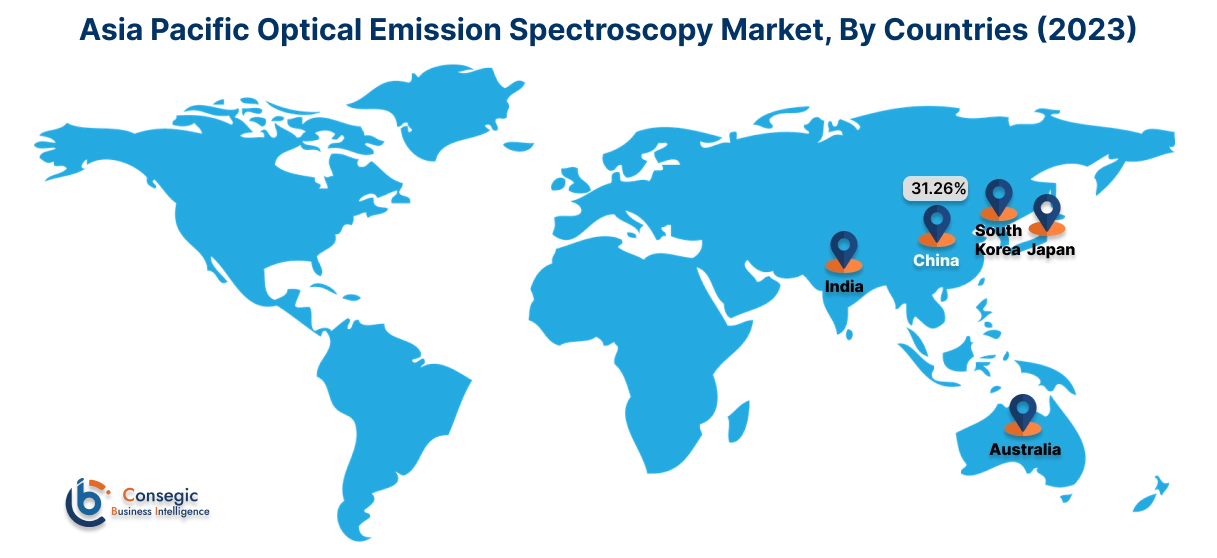
North America market is estimated to reach over USD 474.16 million by 2032 from a value of USD 287.62 million in 2024 and is projected to grow by USD 301.09 million in 2025. The regional growth can be attributed to the presence of numerous environmental testing facilities, pharmaceutical companies, and stringent regulatory frameworks. Furthermore, the increasing focus on environmental sustainability, coupled with the need for compliance with strict regulatory standards, is driving the adoption of ICP-OES technology. These factors would further drive the market in North America.
Moreover, according to the analysis, the optical emission spectroscopy industry in Europe is anticipated to witness significant development during the forecast period. The stringent regulations related to food safety, environmental monitoring, and pharmaceutical quality control are driving the demand for OES systems in the European region.
Additionally, the increasing focus on sustainability and the growing investment in research and development activities are expected to further boost the market growth in Latin America. The primary driver for the OES market in the Middle East and Africa is the region's evolving manufacturing and research sectors, coupled with OES's ability to provide accurate, real-time information on the elemental composition of materials.
Top Key Players & Market Share Insights:
The global optical emission spectroscopy market is highly competitive with major players providing products to the national and international markets. Key players are adopting several strategies in research and development (R&D), product innovation, and end-user launches to hold a strong position in the market. Key players in the optical emission spectroscopy industry include-
- Hitachi High-Tech Analytical Science (U.K.)
- Bruker (Germany)
- Avantes (U.S)
- Thermo Fisher Scientific (U.S.)
- Agilent Technologies (U.S.)
- Shimadzu Corporation (Japan)
- SPECTRO Analytical Instruments GmbH. (Germany)
- JEOL Ltd. (Japan)
- PerkinElmer (U.S.)
- HORIBA Group (Japan)
Recent Industry Developments :
Product Launch:
- In June 2024, Bruker introduced the Q6 NEWTON, a new benchtop spark optical emission spectrometer. This instrument is specifically designed to enhance alloy composition analysis in metals manufacturing, offering improved precision, speed, and reliability.
Optical Emission Spectroscopy Market Report Insights :
| Report Attributes | Report Details |
| Study Timeline | 2019-2032 |
| Market Size in 2032 | USD 1,222.70 Million |
| CAGR (2025-2032) | 5.9% |
| By Offering |
|
| By Form Factor |
|
| By Product Type |
|
| By Application |
|
| By End-User |
|
| By Region |
|
| Key Players |
|
| North America | U.S. Canada Mexico |
| Europe | U.K. Germany France Spain Italy Russia Benelux Rest of Europe |
| APAC | China South Korea Japan India Australia ASEAN Rest of Asia-Pacific |
| Middle East and Africa | GCC Turkey South Africa Rest of MEA |
| LATAM | Brazil Argentina Chile Rest of LATAM |
| Report Coverage |
|
Key Questions Answered in the Report
How big is the Optical Emission Spectroscopy Market? +
Optical Emission Spectroscopy market size is estimated to reach over USD 1,222.70 Million by 2032 from a value of USD 739.74 Million in 2024 and is projected to grow by USD 774.55 Million in 2025, growing at a CAGR of 5.9% from 2025 to 2032.
Which is the fastest-growing region in the Optical Emission Spectroscopy Market? +
Asia-Pacific region is experiencing the most rapid growth in the market.
What specific segmentation details are covered in the Optical Emission Spectroscopy report? +
The optical emission spectroscopy report includes specific segmentation details for offering, form factor, product type, application, end user, and region.
Who are the major players in the Optical Emission Spectroscopy Market? +
The key participants in the market are Hitachi High-Tech Analytical Science (U.K.), Bruker (Germany), Shimadzu Corporation (Japan), SPECTRO Analytical Instruments GmbH. (Germany), JEOL Ltd. (Japan), PerkinElmer (U.S.), HORIBA Group (Japan), Avantes (U.S), Thermo Fisher Scientific (U.S.), Agilent Technologies (U.S.), and others.
What are the key trends in the optical emission spectroscopy Market? +
The optical emission spectroscopy market is being shaped by several key trends including the integration of OES into production process for real time monitoring and control over the quality of metal, increasing rule and regulations in food and beverages industry, rising demand for portable and compact analytical tool for determining the elemental composition of various metals are the key trends driving the market.
